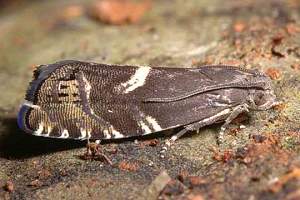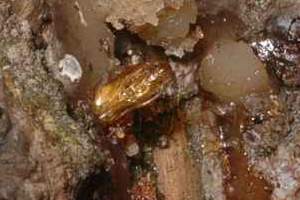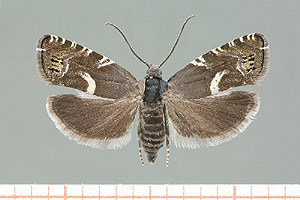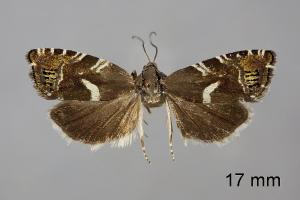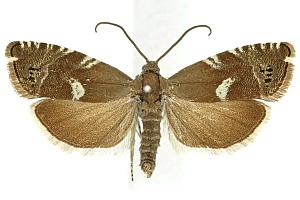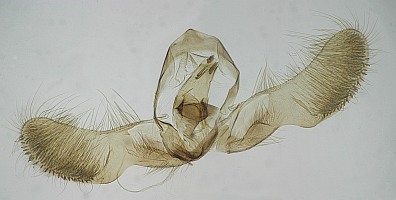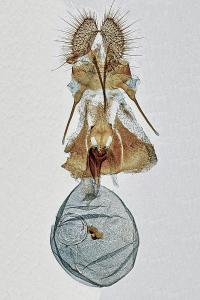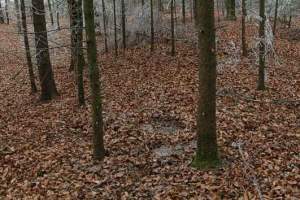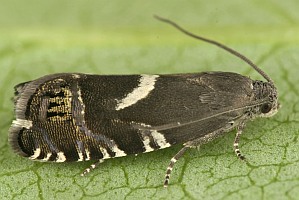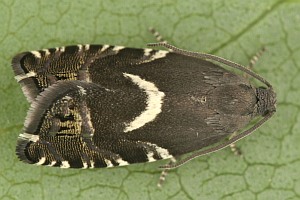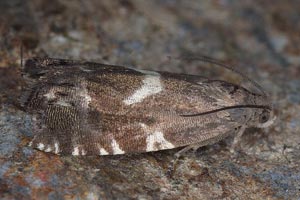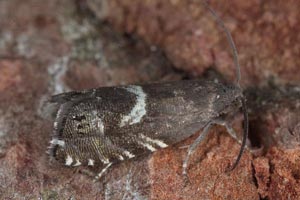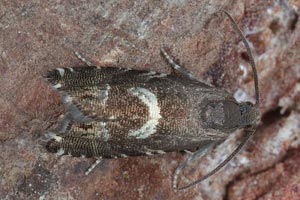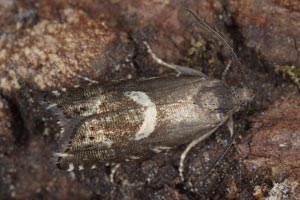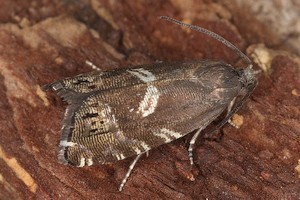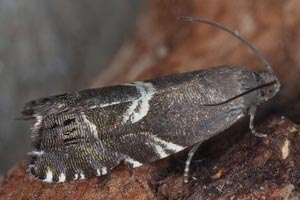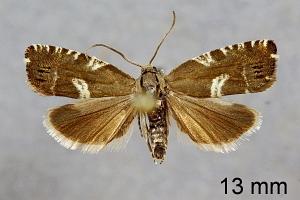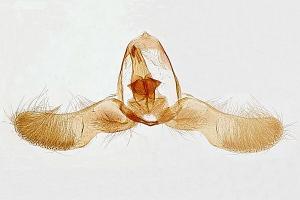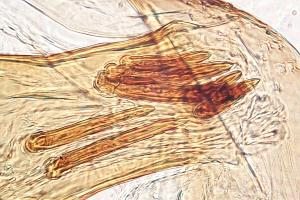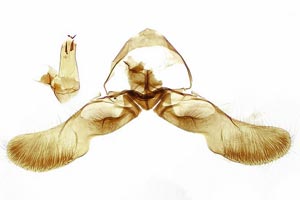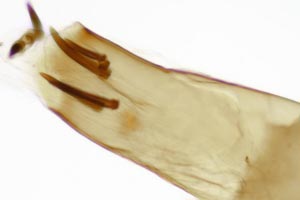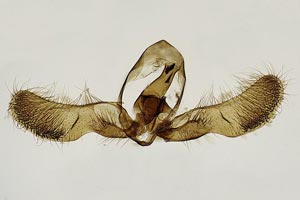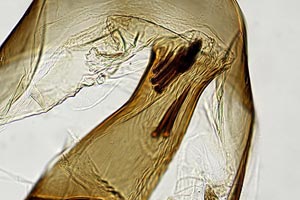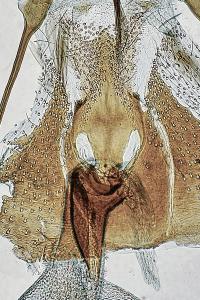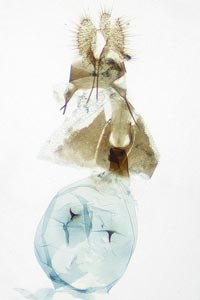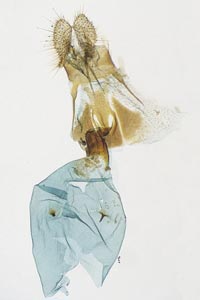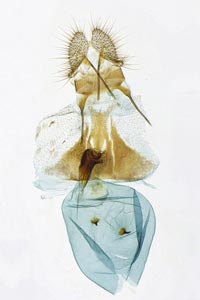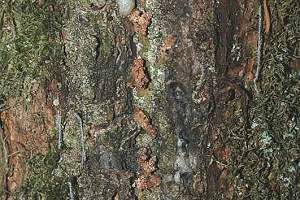1. Lebendfotos
1.1. Falter
1.2. Puppe
2. Diagnose
2.1. Männchen
2.2. Weibchen
2.3. Geschlecht nicht bestimmt
2.4. Genitalien
2.4.1. Männchen
2.4.2. Weibchen
3. Biologie
3.1. Nachweismethoden
3.2. Nahrung der Raupe
- [Pinaceae:] Picea abies (Gewöhnliche Fichte)
- [Pinaceae:] Picea sitchensis (Sitka-Fichte)
- [Pinaceae:] Abies sp. (Tanne)
- [Pinaceae:] Larix decidua (Europäische Lärche)
Razowski (2001: 90) meldete knapp: "unter R[inde]; Abies (Pinaceae)."
Hancock et al. (2015: 187) schrieben: "Ovum. Laid in June on or in the bark of firs (Abies sp.), possibly also utilizes Pinus sp. (Razowski, 2003)." Konkrete Hinweise auf oder gar Funde an Pinus scheint es aber nicht zu geben.
Rudolf Bryner fand seine Raupen in der Schweiz (s.o.) an Rinden-Verletzungsstellen junger Fichten (Picea abies). Warum diese Pflanze in den oben genannten Arbeiten nicht angesprochen wird, ist unverständlich, denn schon Buhl et al. (1984) hatten aus Dänemark berichtet: "Numerous larvae of Cydia indivisa (Danil.) have been found in Funen (F) and some observations on their biology are reported. The main host tree was Picea abies but also Picea sithensis [sic!] was infected. The trees were 15-40 years old, those of 20-30 years of age apparently being preferred. It is easiest to find the species in plantings that have been thinned out. The larvae infect resin-exuding wounds on the sunny side of the trees, and infections are recognizable by frass piles coming out from the margins of the wounds from late March to early May. The larva is grey-white. The head is brown with a darker V-shaped mark. The prothoracic plate, which is divided in the middle, is brown. The whole larva is hairy. It is somewhat difficult to bring the larvae safely home as they easily become smeared with the resin when the galleries are disturbed. In addition the larvae are frequently parasitized. It is therefore most profitable to collect the pupae, which may be found from early May to early June and are located in a white web in the area of resin. Larvae of the muscid fly Phaonia czerny Hennig, 1963 is reported as predators on C. indivisa larvae." Lyneborg (1987) - auf der Suche nach Parasitoiden der Raupen - bestätigt dies.
Szabóky & Buschmann (2010: 198) berichteten aus Ungarn (Sopron, Muck (Restaurant Moha)): "On 17 March 2009 Cydia milleniana (ADAMCZEWSKI, 1967) specimens were collected from larch (Larix decidua) (leg. CS. SZABÓKY & GY. CSÓKA). A web with light brown traces of frass and droppings was hanging from the one year old cones. Nearly one hundred “webby” cones were collected and put into breeding cages. On the first days of May ichneumon wasps emerged from the cones, then later a few Cydia indivisa specimens. This was followed by collecting on the terrace of the Restaurant Moha, with the help of a 125W Hgl bulb and a white sheet (leg. CS. SZABÓKY). Two roughly 80 year old larch trees stood 20 meters from the collecting place, with their branches full of cones. Thirty minutes after dusk the first C. indivisa arrived, and a further six specimens until 11 pm. Rain started before midnight terminating the collecting with a storm. Until now, the known foodplant of C. indivisa were firs (Abies). It is worth mentioning that both firs and larches have erecting cones."
Demnach lebt die Raupe also nicht nur an Rinde, sondern auch um junge Zapfen von Koniferen.
(Autor: Erwin Rennwald)
4. Weitere Informationen
4.1. Andere Kombinationen
- Laspeyresia indivisa Danilevsky, 1963 [Originalkombination]
4.2. Faunistik
Locus typicus nach Danilevsky (1963: 173): „Ленинград, Лисий Нос“ [Russland, St. Petersburg, Lisy Nos].
Die ersten Nachweise aus Frankreich erfolgten durch Pheromon-Einsatz (Chambon (1994: 396)).
4.3. Literatur
- Buhl, O., Karsholt, O., Larsen, K. Palm, E. & K. Schnack (1984): Fund af småsommerfugle fra Danmark i 1983 (Lepidoptera). — Entomologiske Meddelelser, 52: 1-21.
- Chambon, J.-P. (1994): Deux tordeuse nouvelles pour la France (Lepidoptera, Tortricidae). — Bulletin de la Société entomologique de France, 99 (4): 395-396. [zum PDF-Download auf persee.fr]
- Erstbeschreibung: Данилевский, А. С. (1963): Новые виды листоверток (Lepidoptera, Tortricidae) палеарктической фауны [New species of leaf-rollers (Lepidoptera, Tortricidae) of the palaearctic fauna]. — Энтомологическое обозрение 42 (1): 164-177.
- Hancock, E.F., Bland, K.P. & J. Razowski (2015): The moths and butterflies of Great Britain and Ireland. Volume 5 (Part 2). Tortricidae, Olethreutinae. - 377 S.; Leiden & Boston (Brill).
- Lyneborg, L. (1987): On the life history of Chyliza annulipes Macq., 1835 (Diptera: Psilidae). — Entomologiske Meddelelser, 55: 27-29.
- Razowski, J. (2001): Die Tortriciden (Lepidoptera, Tortricidae) Mitteleuropas. Bestimmung - Verbreitung - Flugstandort - Lebensweise der Raupen. — 319 S.; Bratislava.
- Szabóky & Buschmann (2010): New data to the Microlepidoptera fauna of Hungary, part XIII (Lepidoptera: Depressariidae, Pyralidae, Scythrididae, Tortricidae, Yponomeutidae). — Folia Entomologica Hungarica, 71: 197−202. [zum PDF-Download auf researchgate.net]
- Trematerra, P. & M. Colacci (2023): Phtheochroa apenninana, Epinotia cinereana and Cydia indivisa not yet listed in the Italian fauna, Cnephasia kenneli new to Europe (Lepidoptera Tortricidae). — Redia 106: 129-132. [PDF auf redia.at]
- Stark, W. (2022): Neunachweise von Lepidoptera (Schmetterlinge) für Mitteleuropa, Österreich und Niederösterreich sowie Bestätigungen von seltenen und fraglichen Arten – Ergebnisse der Initiative „Leuchtturmprojekt Schmetterlinge Niederösterreich“. – Naturkundliche Mitteilungen aus den Landessammlungen Niederösterreich, 32: 5 - 20. [PDF auf zobodat.at]



![Vorkommen in Österreich [Huemer (2013: NR 2788)]](/res/img/flag/at.png)
![Vorkommen in Norwegen (außer Spitzbergen und Jan Mayen) [Aarvik & al. (2017): Nordic-Baltic Checklist]](/res/img/flag/no.gif)
![Vorkommen in Dänemark (außer Färöer-Inseln und Grönland) [Aarvik & al. (2017): Nordic-Baltic Checklist]](/res/img/flag/dk.gif)
![Vorkommen in Schweden [Aarvik & al. (2017): Nordic-Baltic Checklist]](/res/img/flag/se.gif)
![Vorkommen in Finnland (außer Åland-Inseln) [Aarvik & al. (2017): Nordic-Baltic Checklist]](/res/img/flag/fi.gif)
![Vorkommen in Russland (europäischer Teil bis Manytsch-Niederung) [Kozlov, Kullberg & Zverev (2014)]](/res/img/flag/ru.gif)
![Vorkommen in Estland [Aarvik & al. (2017): Nordic-Baltic Checklist]](/res/img/flag/ee.gif)
![Vorkommen in Lettland [Aarvik & al. (2017): Nordic-Baltic Checklist]](/res/img/flag/lv.gif)
![Vorkommen in Litauen [Aarvik & al. (2017): Nordic-Baltic Checklist]](/res/img/flag/lt.gif)
![Vorkommen in Polen [Buszko J. & J. Nowacki [eds] (2017): A Distributional Checklist of the Lepidoptera of Poland]](/res/img/flag/pl.gif)
![Vorkommen in Tschechien [Laštůvka, Z. & J. Liška (2011): Komentovaný seznam motýlů České republiky]](/res/img/flag/cz.gif)

![Vorkommen in Ungarn [Pastorális et. al. (2018): A Magyarországon előforduló molylepke-fajok névjegyzéke]](/res/img/flag/hu.gif)
![Vorkommen in Großbritannien [Agassiz, Beavan & Heckford (2013): Checklist of the Lepidoptera of the British Isles]](/res/img/flag/gb.gif)
![Vorkommen in Belgien [De Prins W. & Steeman C. 2003–2021. *Catalogue of the Lepidoptera of Belgium*.]](/res/img/flag/be.gif)
![Vorkommen in den Niederlanden [Kuchlein & de Vos (1999): Annotated Checklist of the Dutch Lepidoptera]](/res/img/flag/nl.gif)
![Vorkommen in Luxemburg [Hellers (2002): Die Wickler Luxemburgs]](/res/img/flag/lu.gif)
![Vorkommen in Frankreich (europäisches Territorium ohne Korsika) [Vandromme et al. (2020): Liste systématique et taxinomique des Lépidoptères de France]](/res/img/flag/fr.gif)
![Einzelnachweis in Italien (Festland und kleine festlandsnahe Inseln) [Trematerra & Colacci (2023)]](/res/img/flag/it.gif)
![Vorkommen in Rumänien [Rákosy L. & M. Goia (2021): Lepidopterle din România: lista sistematică şi distribuţie]](/res/img/flag/ro.gif)
